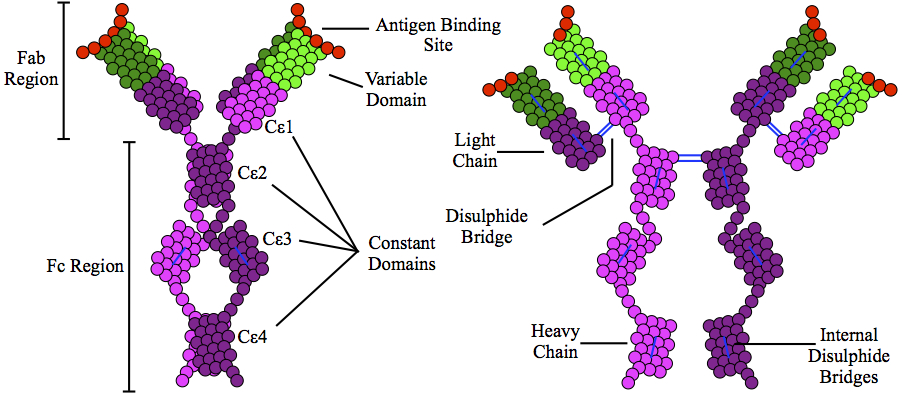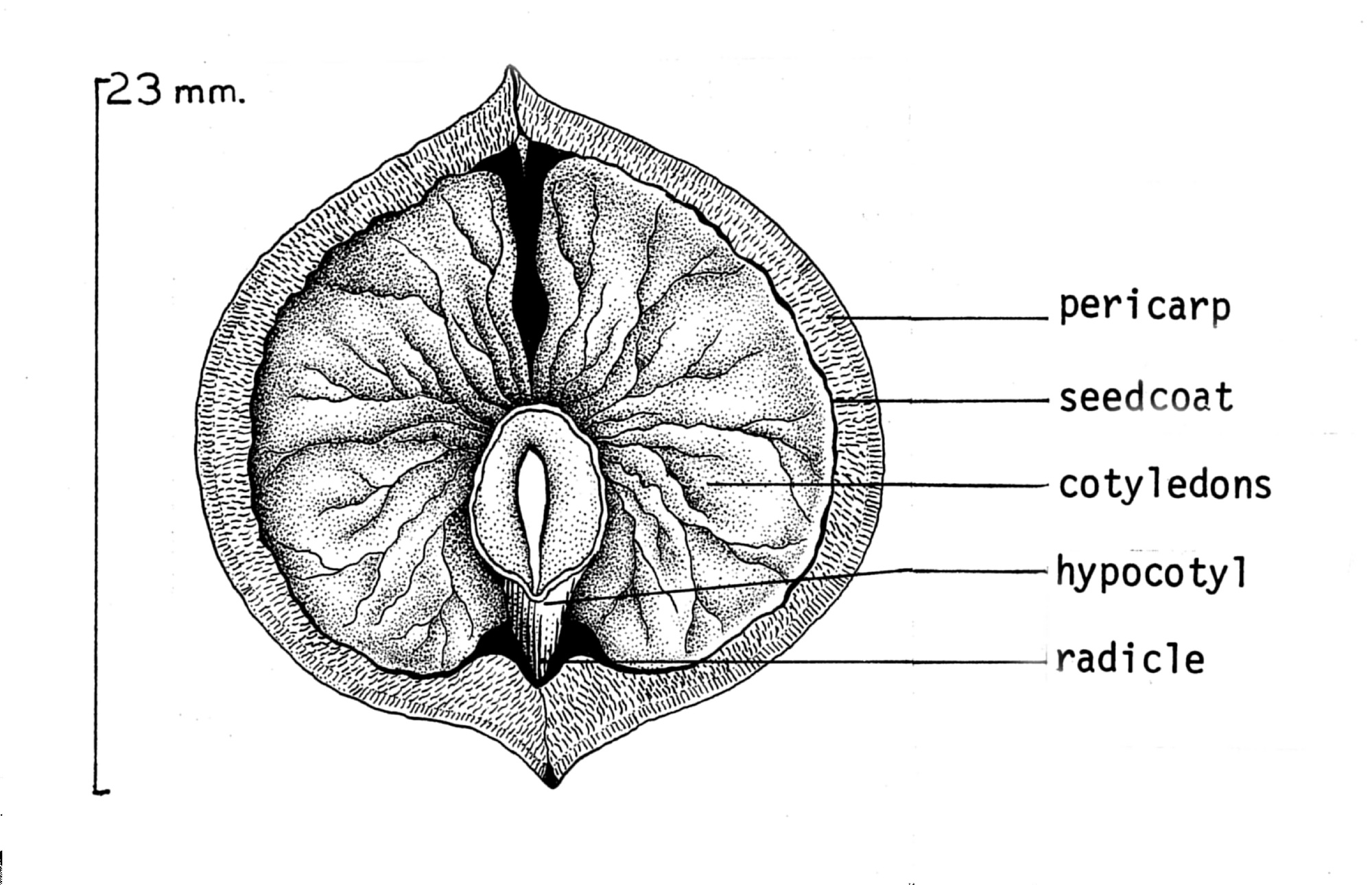|
Allergen
An allergen is an otherwise harmless substance that triggers an allergic reaction in sensitive individuals by stimulating an immune response. In technical terms, an allergen is an antigen that is capable of stimulating a type-I hypersensitivity reaction in atopic individuals through immunoglobulin E (IgE) responses. Most humans mount significant immunoglobulin E responses only as a defense against parasitic infections. However, some individuals may respond to many common environmental antigens. This hereditary predisposition is called atopy. In atopic individuals, non-parasitic antigens stimulate inappropriate IgE production, leading to type I hypersensitivity. Sensitivities vary widely from one person (or from one animal) to another. A very broad range of substances can be allergens to sensitive individuals. Examples Allergens can be found in a variety of sources, such as dust mite excretion, pollen, pet dander, or even royal jelly. Food allergies are not as co ... [...More Info...] [...Related Items...] OR: [Wikipedia] [Google] [Baidu] |
Allergic Reaction
Allergies, also known as allergic diseases, are various conditions caused by hypersensitivity of the immune system to typically harmless substances in the environment. These diseases include Allergic rhinitis, hay fever, Food allergy, food allergies, atopic dermatitis, allergic asthma, and anaphylaxis. Symptoms may include allergic conjunctivitis, red eyes, an itchy rash, sneeze, sneezing, coughing, a rhinorrhea, runny nose, shortness of breath, or swelling. Note that food intolerances and food poisoning are separate conditions. Common allergens include pollen and certain foods. Metals and other substances may also cause such problems. Food, insect stings, and medications are common causes of severe reactions. Their development is due to both genetic and environmental factors. The underlying mechanism involves immunoglobulin E antibodies (IgE), part of the body's immune system, binding to an allergen and then to FcεRI, a receptor on mast cells or basophils where it triggers ... [...More Info...] [...Related Items...] OR: [Wikipedia] [Google] [Baidu] |
Latex Allergy
Latex allergy is a medical term encompassing a range of allergic reactions to the proteins present in natural rubber latex. It generally develops after repeated exposure to products containing natural rubber latex. When latex-containing medical devices or supplies come in contact with mucous membranes, the membranes may absorb latex proteins. In some susceptible people, the immune system produces antibodies that react immunologically with these antigenic proteins. Many items contain or are made from natural rubber, including shoe soles, pen grips, hot water bottles, elastic bands, rubber gloves, condoms, baby-bottle nipples, and balloons; consequently, there are many possible routes of exposure that may trigger a reaction. People with latex allergies may also have or develop allergic reactions to some fruits, such as bananas. Signs and symptoms Allergic reactions to latex range from Type I hypersensitivity, the most serious form of reaction, to Type IV hypersensitivity. R ... [...More Info...] [...Related Items...] OR: [Wikipedia] [Google] [Baidu] |
Atopy
Atopy is the tendency to produce an exaggerated immunoglobulin E (IgE) immune response to otherwise harmless substances in the environment. Allergic diseases are clinical manifestations of such inappropriate, atopic responses. Atopy may have a hereditary component, although contact with the allergen or irritant must occur before the hypersensitivity reaction can develop (characteristically after re-exposure). Maternal psychological trauma during pregnancy may also be a strong indicator for development of atopy. The term ''atopy'' was coined by Arthur F. Coca and Robert Cooke in 1923 from the Greek ἀτοπία meaning "the state of being out of place", "absurdity". Many physicians and scientists use the term ''atopy'' for any reaction mediated by IgE (even those that are appropriate and proportional to the antigen), but many pediatricians reserve it to refer only to a genetically mediated predisposition to an excessive IgE reaction. Signs and symptoms Atopic sensitiz ... [...More Info...] [...Related Items...] OR: [Wikipedia] [Google] [Baidu] |
Dust Mite
House dust mites (HDM, or simply dust mites) are various species of acariform mites belonging to the family Pyroglyphidae that are found in association with dust in dwellings. They are known for causing allergies. Biology Species The currently known species are: * '' Blomia tropicalis'' * '' Dermatophagoides farinae'' (American house dust mite) * '' Dermatophagoides pteronyssinus'' (European house dust mite) * '' Dermatophagoides evansi'' * '' Dermatophagoides microceras'' * '' Dermatophagoides halterophilus'' * '' Dermatophagoides siboney'' * '' Dermatophagoides neotropicalis'' * '' Dermatophagoides alexfaini'' * '' Dermatophagoides anisopoda'' * '' Dermatophagoides chirovi'' * '' Dermatophagoides deanei'' * '' Dermatophagoides rwandae'' * '' Dermatophagoides scheremeteroskyi'' * '' Dermatophagoides scheremetewskyi'' * '' Dermatophagoides simplex'' * '' Euroglyphus maynei'' (Mayne's house dust mite) * '' Euroglyphus longior'' * '' Hirstia domicola'' * '' Malayoglyphus carmeli ... [...More Info...] [...Related Items...] OR: [Wikipedia] [Google] [Baidu] |
Peanut
The peanut (''Arachis hypogaea''), also known as the groundnut, goober (US), goober pea, pindar (US) or monkey nut (UK), is a legume crop grown mainly for its edible seeds. It is widely grown in the tropics and subtropics by small and large commercial producers, both as a grain legume and as an oil crop. Atypically among legumes, peanut pods geocarpy, develop underground; this led botanist Carl Linnaeus to name peanuts ''hypogaea'', which means "under the earth". The peanut belongs to the botanical family Fabaceae (or Leguminosae), commonly known as the legume, bean, or pea family. Like most other legumes, peanuts harbor symbiotic nitrogen-fixing bacteria in root nodules, which improve soil fertility, making them valuable in crop rotations. Despite not meeting the Botanical nut, botanical definition of a nut as "a fruit whose ovary (botany), ovary wall becomes hard at maturity," peanuts are usually categorized as nuts for culinary purposes and in common English. Some pe ... [...More Info...] [...Related Items...] OR: [Wikipedia] [Google] [Baidu] |
House Dust Mite
House dust mites (HDM, or simply dust mites) are various species of acariform mites belonging to the family Pyroglyphidae that are found in association with dust in dwellings. They are known for causing allergies. Biology Species The currently known species are: * '' Blomia tropicalis'' * '' Dermatophagoides farinae'' (American house dust mite) * '' Dermatophagoides pteronyssinus'' (European house dust mite) * '' Dermatophagoides evansi'' * '' Dermatophagoides microceras'' * '' Dermatophagoides halterophilus'' * '' Dermatophagoides siboney'' * '' Dermatophagoides neotropicalis'' * '' Dermatophagoides alexfaini'' * '' Dermatophagoides anisopoda'' * '' Dermatophagoides chirovi'' * '' Dermatophagoides deanei'' * '' Dermatophagoides rwandae'' * '' Dermatophagoides scheremeteroskyi'' * '' Dermatophagoides scheremetewskyi'' * '' Dermatophagoides simplex'' * '' Euroglyphus maynei'' (Mayne's house dust mite) * '' Euroglyphus longior'' * '' Hirstia domicola'' * '' Malayoglyphus carmel ... [...More Info...] [...Related Items...] OR: [Wikipedia] [Google] [Baidu] |
Food Sensitivity
Food intolerance is a detrimental reaction, often delayed, to a food, beverage, food additive, or compound found in foods that produces symptoms in one or more body organs and systems, but generally refers to reactions other than food allergy. Food hypersensitivity is used to refer broadly to both food intolerances and food allergies. Food allergies are immune reactions, typically an Immunoglobulin E, IgE reaction caused by the release of histamine but also encompassing non-IgE immune responses. This mechanism causes allergies to typically give immediate reaction (a few minutes to a few hours) to foods. Food intolerances can be classified according to their mechanism. Intolerance can result from the absence of specific chemicals or enzymes needed to digestion, digest a food substance, as in hereditary fructose intolerance. It may be a result of an abnormality in the body's ability to absorb nutrients, as occurs in fructose malabsorption. Food intolerance reactions can occur to na ... [...More Info...] [...Related Items...] OR: [Wikipedia] [Google] [Baidu] |
Immunoglobulin E
Immunoglobulin E (IgE) is a type of antibody (or immunoglobulin (Ig) " isoform") that has been found only in mammals. IgE is synthesised by plasma cells. Monomers of IgE consist of two heavy chains (ε chain) and two light chains, with the ε chain containing four Ig-like constant domains (Cε1–Cε4). IgE is thought to be an important part of the immune response against infection by certain parasitic worms, including '' Schistosoma mansoni'', ''Trichinella spiralis'', and ''Fasciola hepatica''. IgE is also utilized during immune defense against certain protozoan parasites such as ''Plasmodium falciparum''. IgE may have evolved as a defense to protect against venoms. IgE also has an essential role in type I hypersensitivity, which manifests in various allergic diseases, such as allergic asthma, most types of sinusitis, allergic rhinitis, food allergies, and specific types of chronic urticaria and atopic dermatitis. IgE also plays a pivotal role in responses to allergens, such ... [...More Info...] [...Related Items...] OR: [Wikipedia] [Google] [Baidu] |
Nut (fruit)
A nut is a fruit consisting of a hard or tough nutshell protecting a kernel which is usually edible. In general usage and in a culinary sense, many dry seeds are called nuts, but in a botanical context, "nut" implies that the shell does not open to release the seed (Dehiscence (botany), indehiscent). Most seeds come from fruits that naturally free themselves from the shell, but this is not the case in nuts such as hazelnuts, chestnuts, and acorns, which have hard shell walls and originate from a compound ovary. Definition A seed is the mature fertilised ovule of a plant; it consists of three parts, the embryo which will develop into a new plant, stored food for the embryo, and a protective seed coat. Botany, Botanically, a nut is a fruit with a woody pericarp developing from a syncarpous gynoecium. Nuts may be contained in an Bract#Involucral bracts, involucre, a cup-shaped structure formed from the flower bracts. The involucre may be scaly, spiny, leafy or tubular, depending ... [...More Info...] [...Related Items...] OR: [Wikipedia] [Google] [Baidu] |
Seafood
Seafood is any form of Marine life, sea life regarded as food by humans, prominently including Fish as food, fish and shellfish. Shellfish include various species of Mollusca, molluscs (e.g., bivalve molluscs such as clams, oysters, and mussels, and cephalopods such as octopus and squid), crustaceans (e.g. shrimp, crabs, and lobster), and echinoderms (e.g. sea cucumbers and sea urchins). Historically, marine mammals such as cetaceans (whales and dolphins) as well as Pinniped, seals have been eaten as food, though that happens to a lesser extent in modern times. Edible sea plants such as some Edible seaweed, seaweeds and microalgae are widely eaten as :edible seaweeds, sea vegetables around the world, especially in Asia. Seafood is an important source of (animal) protein in many Diet (nutrition), diets around the world, especially in coastal areas. Semi-vegetarianism, Semi-vegetarians who consume seafood as the only source of meat are said to adhere to pescetarianism. The harv ... [...More Info...] [...Related Items...] OR: [Wikipedia] [Google] [Baidu] |
Pollen
Pollen is a powdery substance produced by most types of flowers of seed plants for the purpose of sexual reproduction. It consists of pollen grains (highly reduced Gametophyte#Heterospory, microgametophytes), which produce male gametes (sperm cells). Pollen grains have a hard coat made of sporopollenin that protects the gametophytes during the process of their movement from the stamens to the pistil of flowering plants, or from the male Conifer cone, cone to the female cone of gymnosperms. If pollen lands on a compatible pistil or female cone, it Germination, germinates, producing a pollen tube that transfers the sperm to the ovule containing the female gametophyte. Individual pollen grains are small enough to require magnification to see detail. The study of pollen is called palynology and is highly useful in paleoecology, paleontology, archaeology, and Forensic science, forensics. Pollen in plants is used for transferring Ploidy#Haploid and monoploid, haploid male genetic ma ... [...More Info...] [...Related Items...] OR: [Wikipedia] [Google] [Baidu] |
Poison-ivy (plant)
Poison ivy is a type of allergenic plant in the genus ''Toxicodendron'' native to Asia and North America. Formerly considered a single species, ''Toxicodendron radicans'', poison ivies are now generally treated as a complex of three separate species: ''T. radicans'', '' T. rydbergii'', and '' T. orientale''. They are well known for causing urushiol-induced contact dermatitis, an itchy, irritating, and sometimes painful rash, in most people who touch them. The rash is caused by urushiol, a clear liquid compound in the plant's sap. They are variable in appearance and habit, and despite its common name, it is not a "true" ivy (''Hedera''), but rather a member of the cashew and pistachio family (Anacardiaceae). ''T. radicans'' is commonly eaten by many animals, and the seeds are consumed by birds, but poison ivy is most often thought of as an unwelcome weed. Species Three species of poison ivy are generally recognised; they are sometimes considered subspecies of ... [...More Info...] [...Related Items...] OR: [Wikipedia] [Google] [Baidu] |








